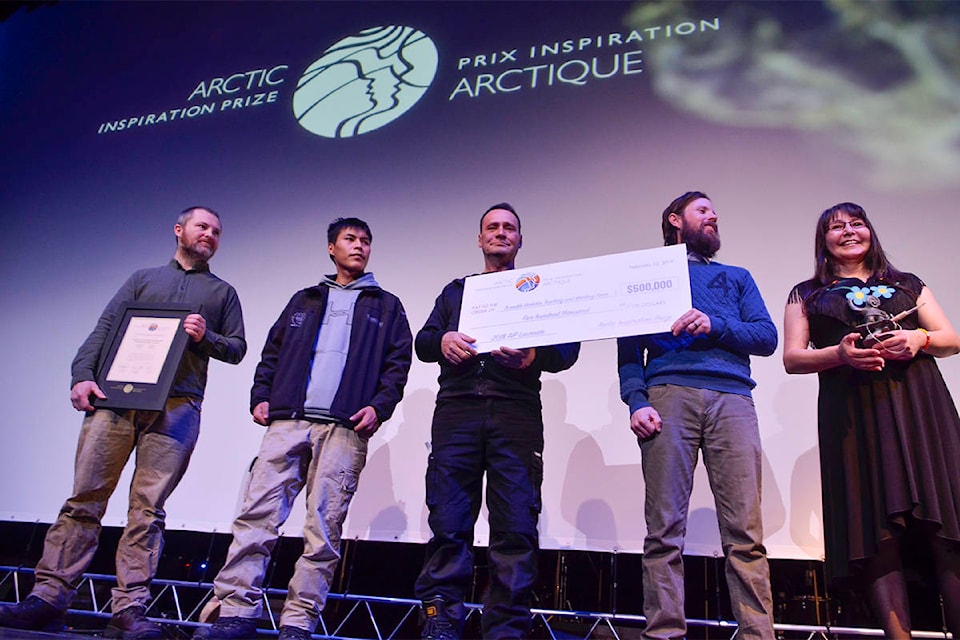The Tr’ondëk Hwëch’in Teaching and Working Farm’s project to build a greenhouse that will allow for farming to take place for up to 10 months of the year was awarded a combined $1 million at the 2018 Arctic Inspiration Prize ceremony at Whitehorse Feb. 12.
The ceremony, held at the Yukon Arts Centre, was the first one in the prize’s seven-year history to be held in the North. The annual event awards money from an up to $3-million pool to innovative projects dedicated to improving the lives of Northern residents.
The Tr’ondëk Hwëch’in (TH) Teaching and Working Farm, located in the Dawson area and run by the First Nation and Yukon College, was one of three winners — also known as “laureates” — in the AIP category, receiving the maximum amount of $500,000.
The project also received an additional $500,000 from the Canadian government, funding that Yukon MP Larry Bagnell shared in an emotional “special announcement” after the TH farm team had already taken to the stage to accept its award.
The farm will be putting the money towards the construction of an extended-season cold-climate greenhouse, the first of its kind in the territory and an idea that will be able to be replicated in communities across the North.
While it currently produces eggs year-round, the farm’s current produce production is limited to the spring and summer months.
In an interview afterwards, TH Chief Roberta Joseph said that, especially with the “unwelcomed, incremental effects” of climate change and global warming on traditional food sources, it’s crucial for TH citizens to have a local, sustainable way to access fresh produce and meats.
“There’s been a great decline in chinook salmon, one of our main food sources, the Porcupine caribou (herd) has a different migration … We have a lot of traditional foods that are no longer fully accessible, the way we used to be able to harvest without limitations,” she said.
“We have to heed the advice of our elders that have passed on this information to us, this vision for (future) generations to develop food security.”
Along with creating food, Joseph added, the farm and the coming greenhouse also offer another valuable opportunity for locals — a chance to share knowledge.
“Not only will it provide food security, it’s also an opportunity for our citizens and others to learn how to develop and manage and greenhouse. There’s a lot of elements involved,” she said.
Depending on when all the appropriate paperwork is in place and when building materials arrive, Joseph said construction will likely begin after the ground thaws and dries this spring. TH is also hoping to sign a funding agreement with the federal government to keep the greenhouse going.
In a separate interview, farm manager Derrick Hastings also highlighted the importance of the learning and teaching that takes place at the farm, explaining that having operations run nearly year-round will create a “continuity” for people and allow them to become professionals instead of just seasonal workers or farmhands.
The greenhouse will allow the farm to grow produce like pak choi, bok choi, spinaches, microgreens, sunflower sprouts, pea shoots, Chinese cabbage, green onions and various herbs well into the fall and winter months, Hastings said — basically, produce that can grow densely and doesn’t need too high of a temperature to flourish.
The farm team will also be experimenting to see what else can be easily grown in the facility.
“It all depends on how effective this facility is, how warm it stays, but potentially, we’ll be growing tomatoes 10 months a year, which would be awesome,” he said.
Other winners in the AIP category included an initiative to form an association of Indigenous northern artists, entitled “Traditional Techniques Tweaked to Galvanize Indigenous Northern Artisans,” and “Nunami Sukuijainiq: A Youth Arctic Ecology Land Camp Program,” a land-based science education program for youth in Nunavik. The projects received $500,000 and $466,000, respectively.
The night’s top prize of $1 million went to Pirurvik: A Place to Grow, a Nunavut preschool that offers “an innovative and comprehensive early childhood education program rooted in traditional child-rearing practices that aims to change the lives of children” across the territory, according to a press release.
“From Scrap to Art,” a Cambridge Bay-based project that will set up a welding studio in the community where youth can learn welding and artistic skills from Inuit, Maori and northern educators, was the only winner in the youth category, receiving a $100,000 prize.
Contact Jackie Hong at jackie.hong@yukon-news.com
